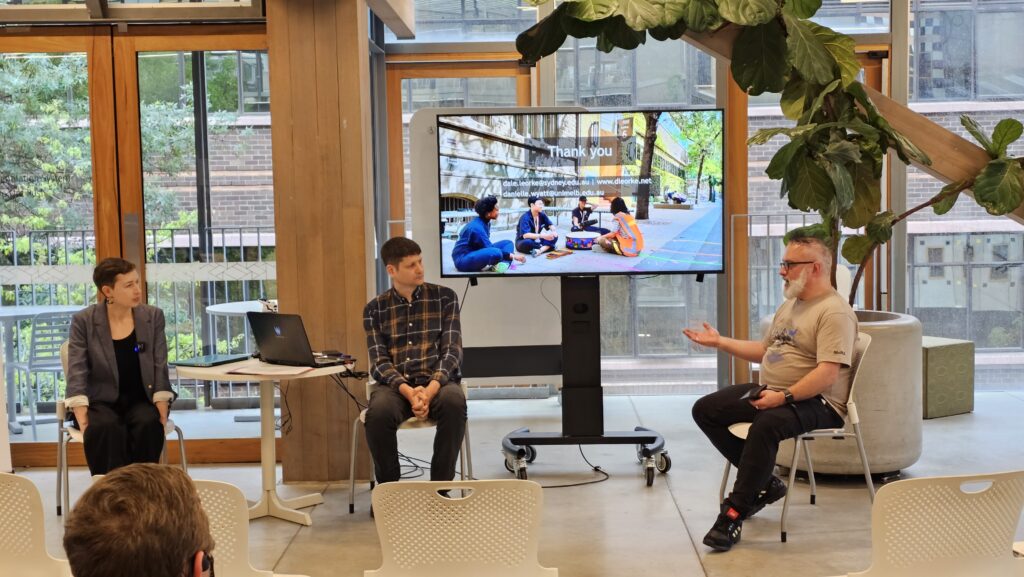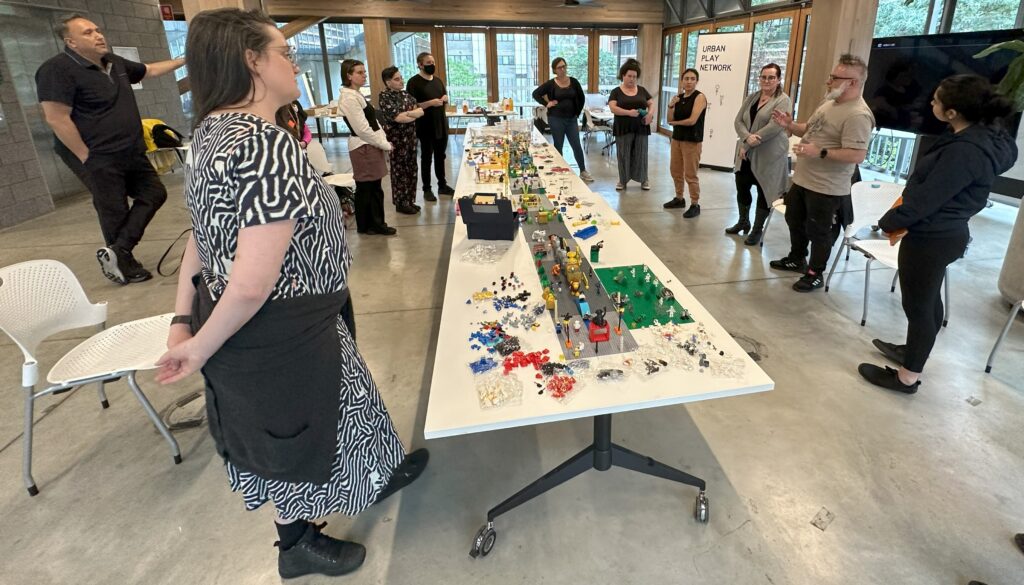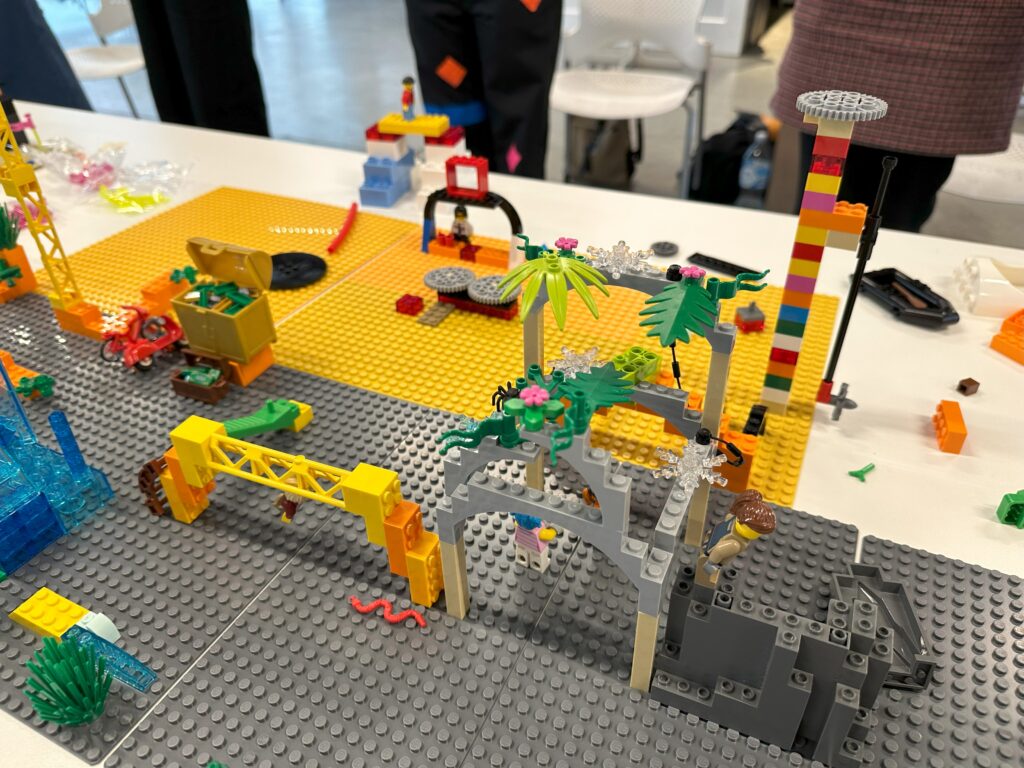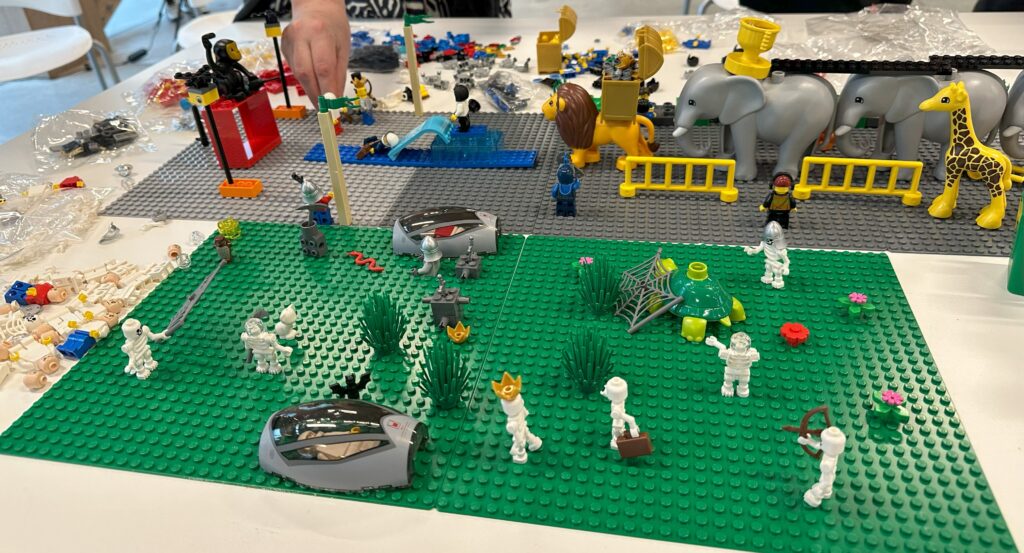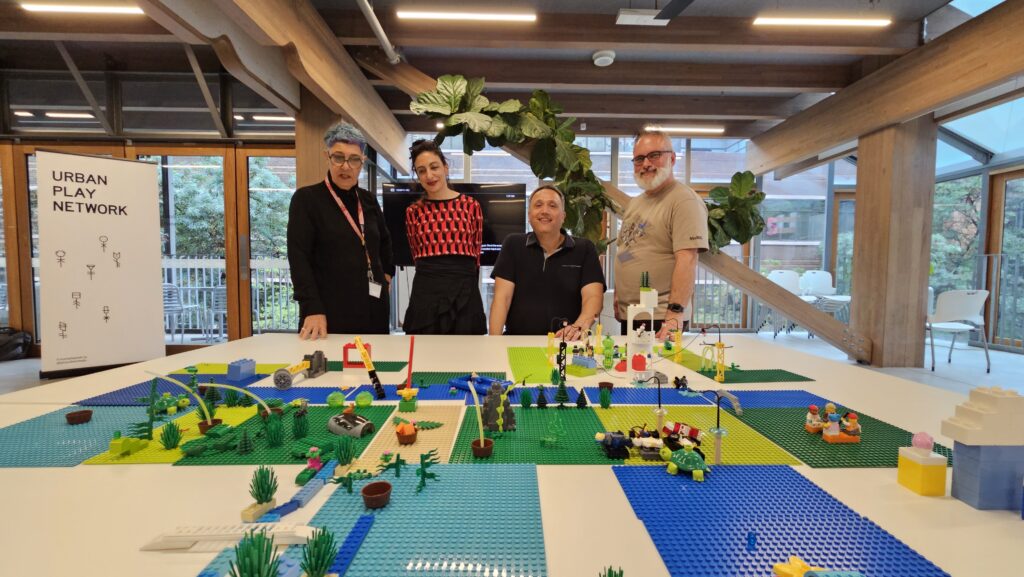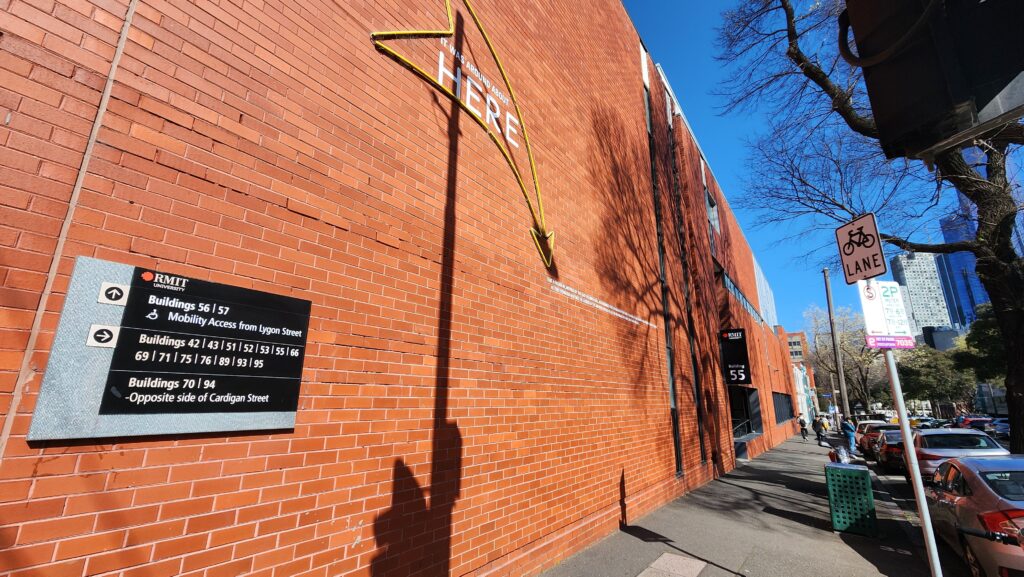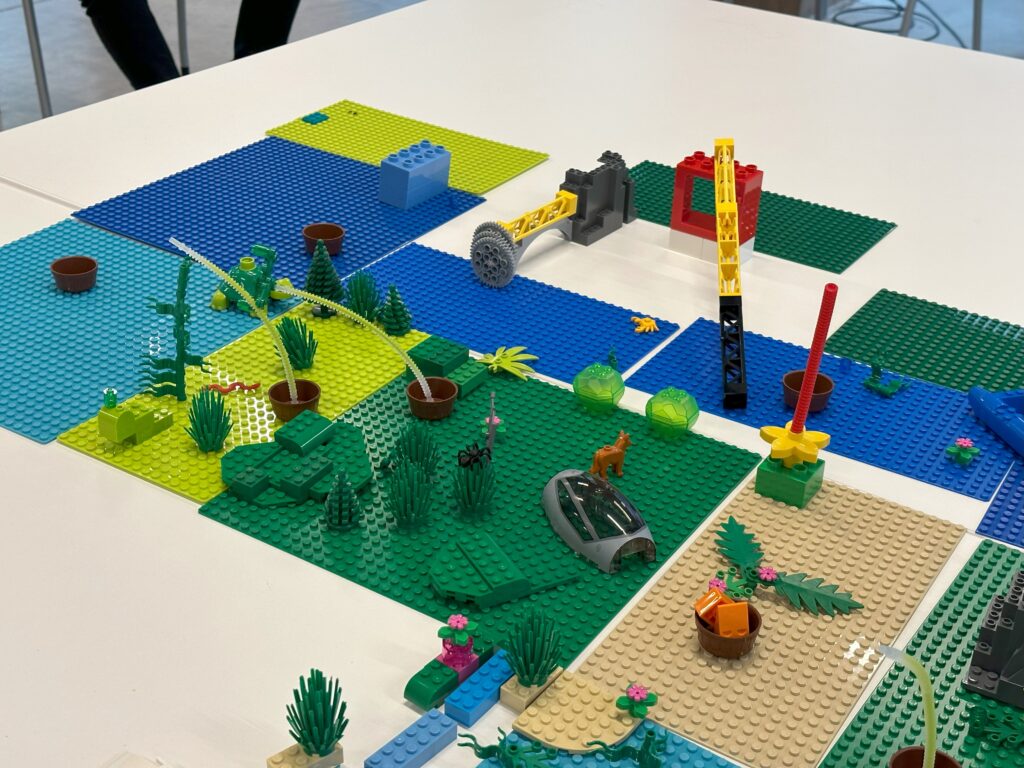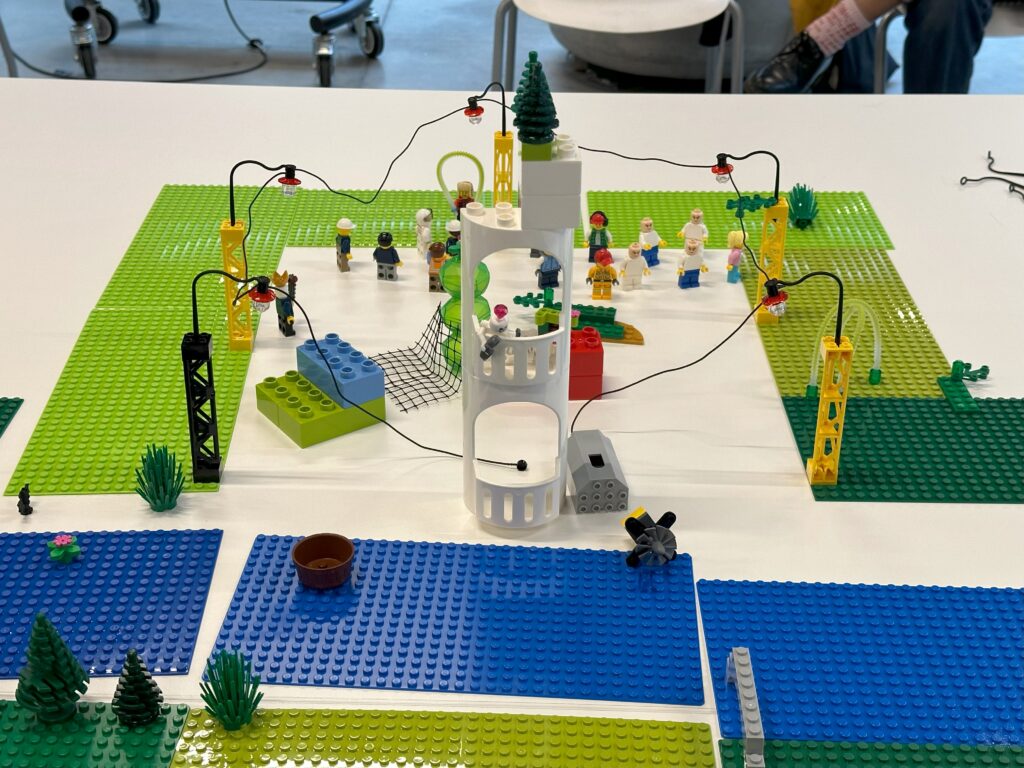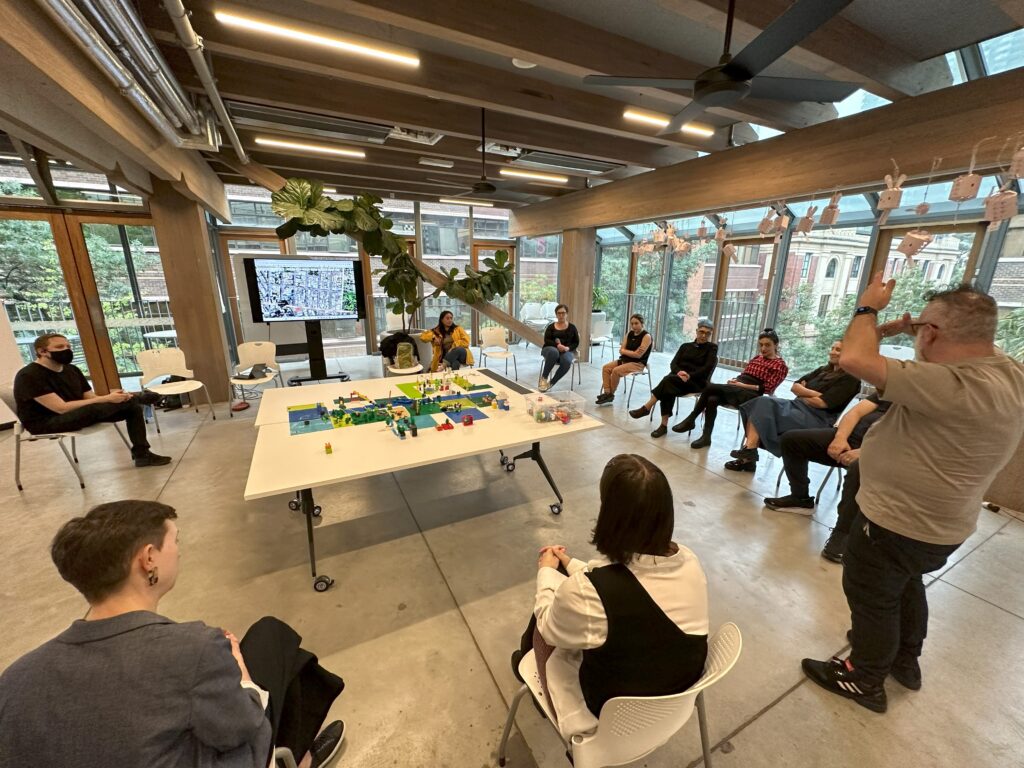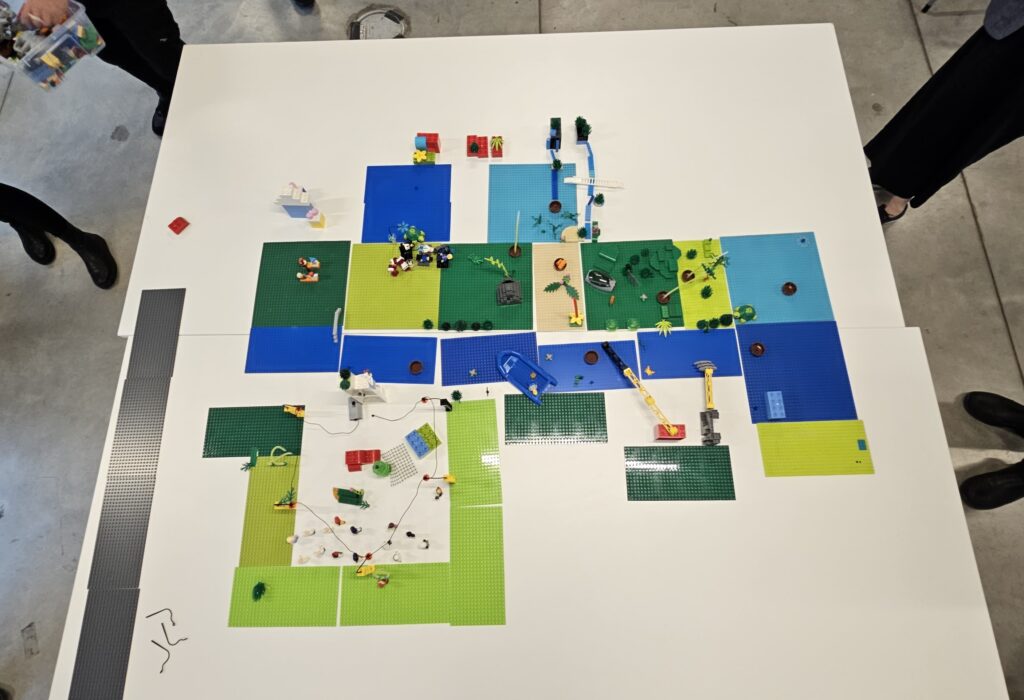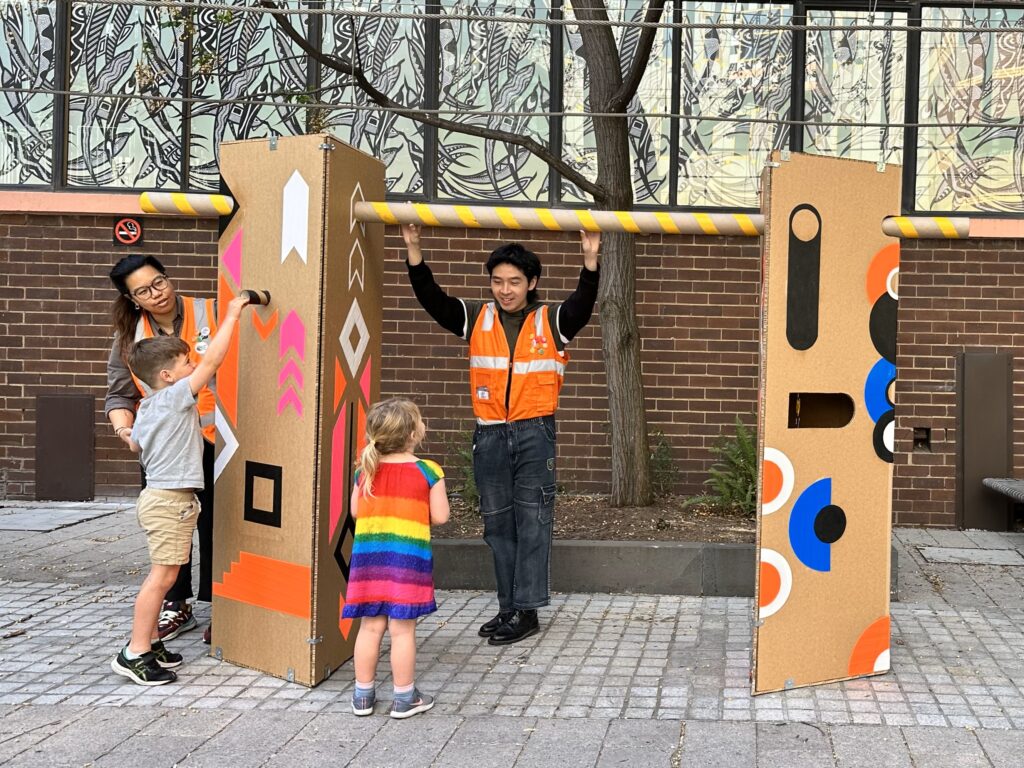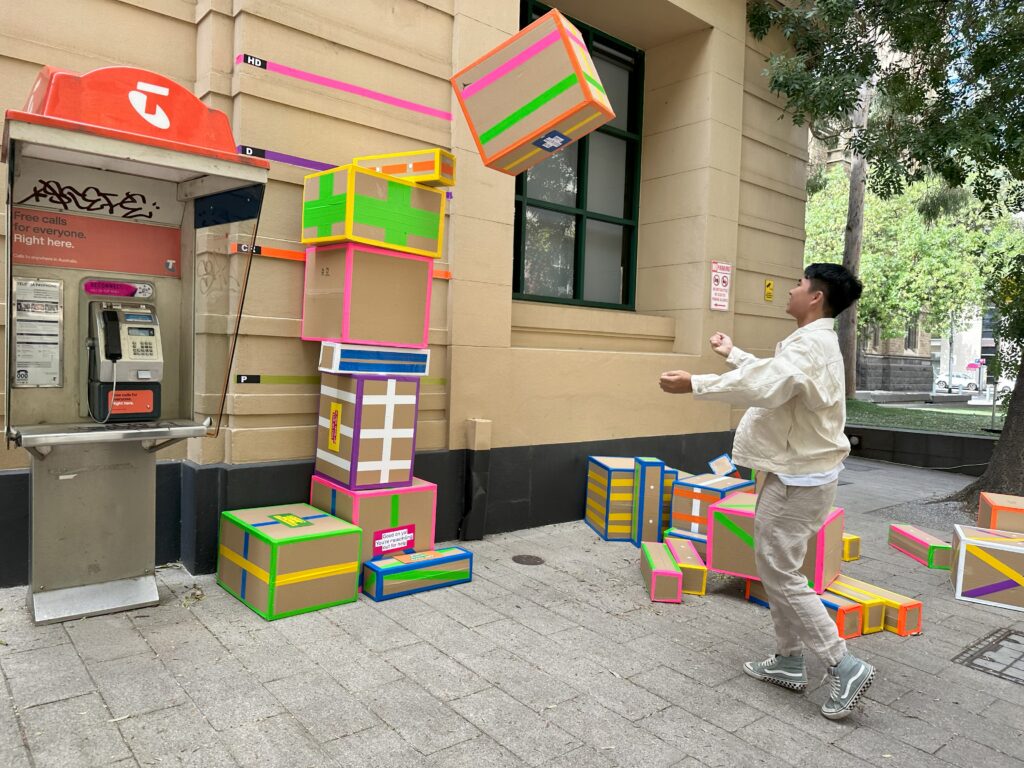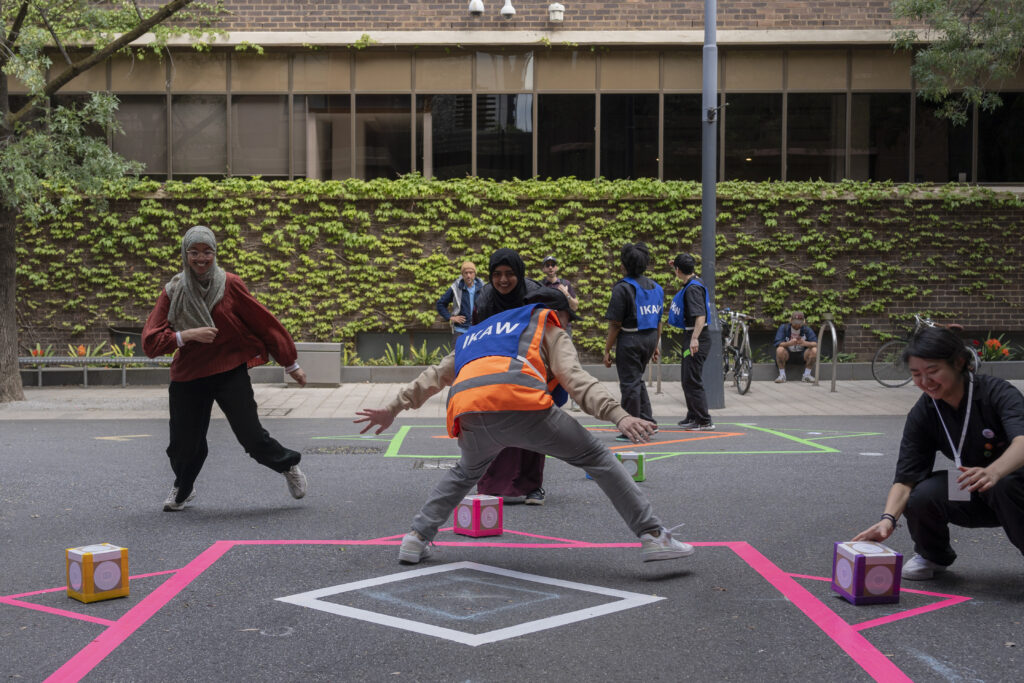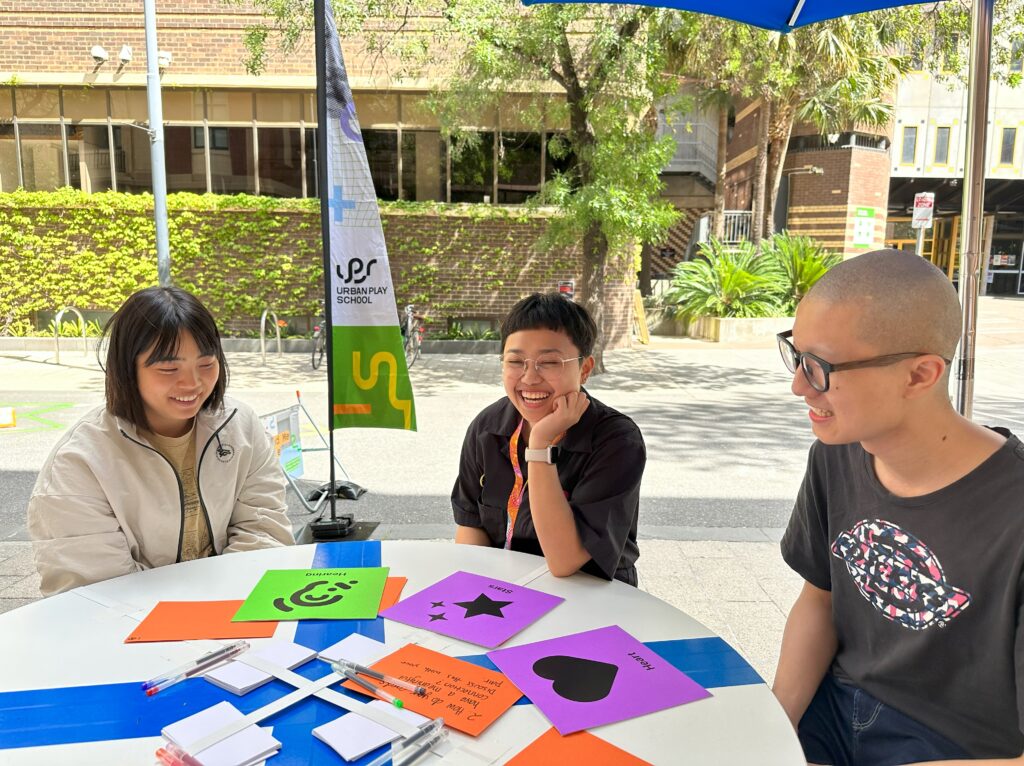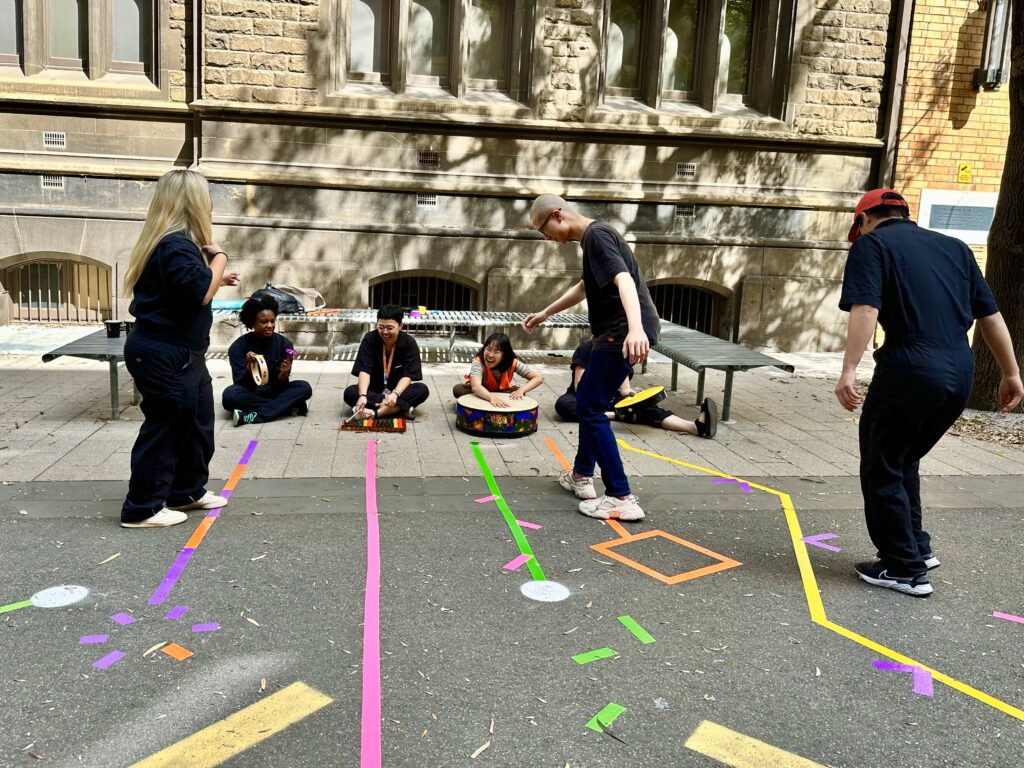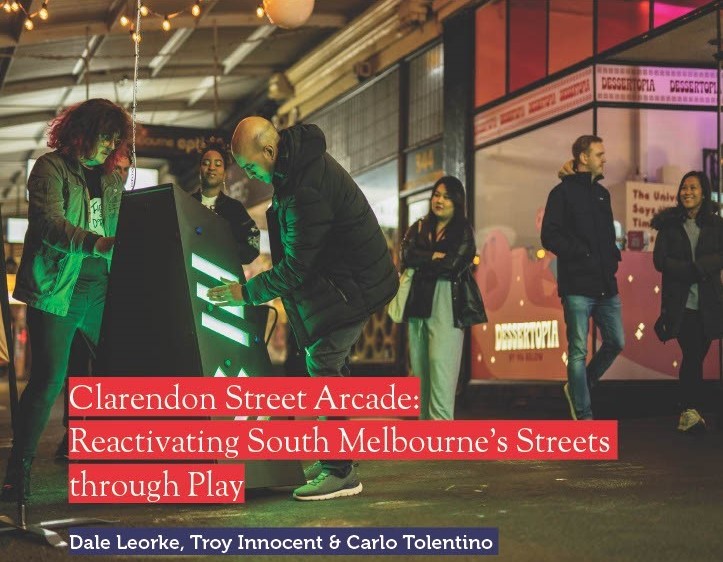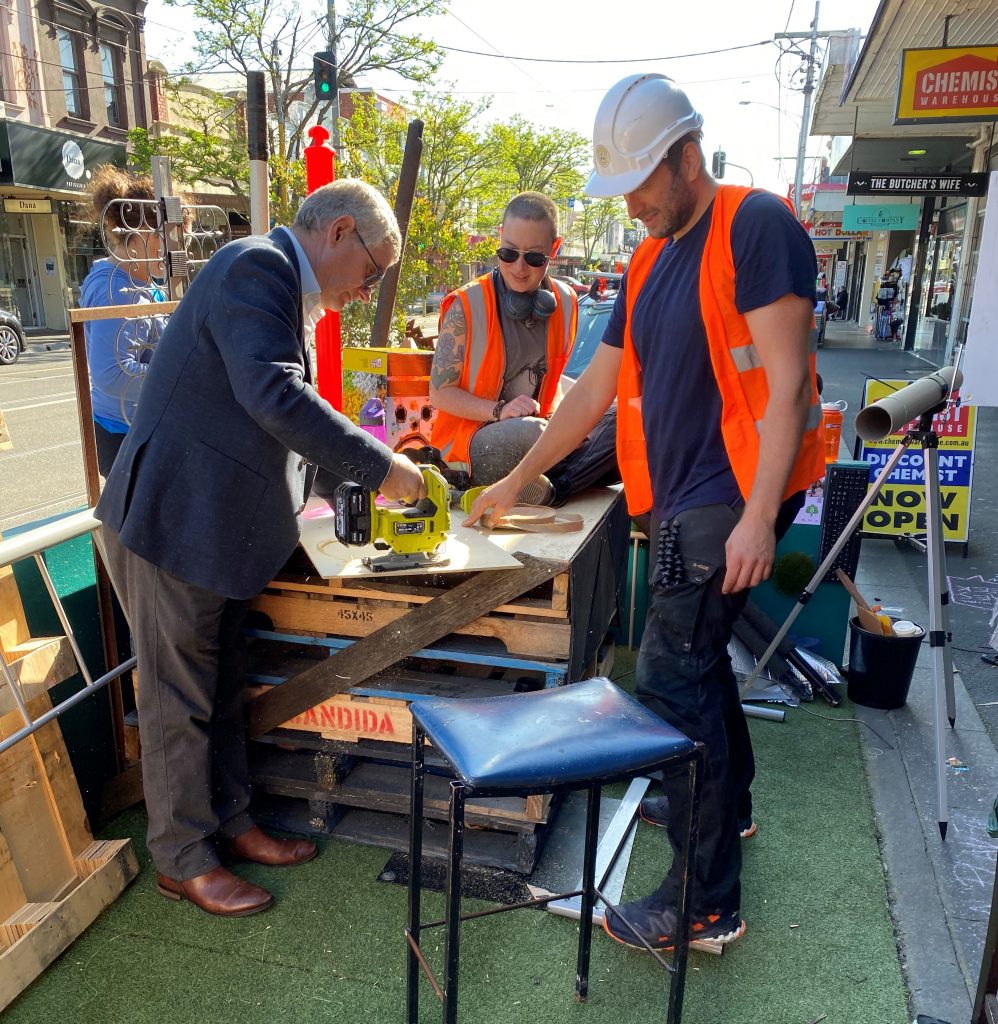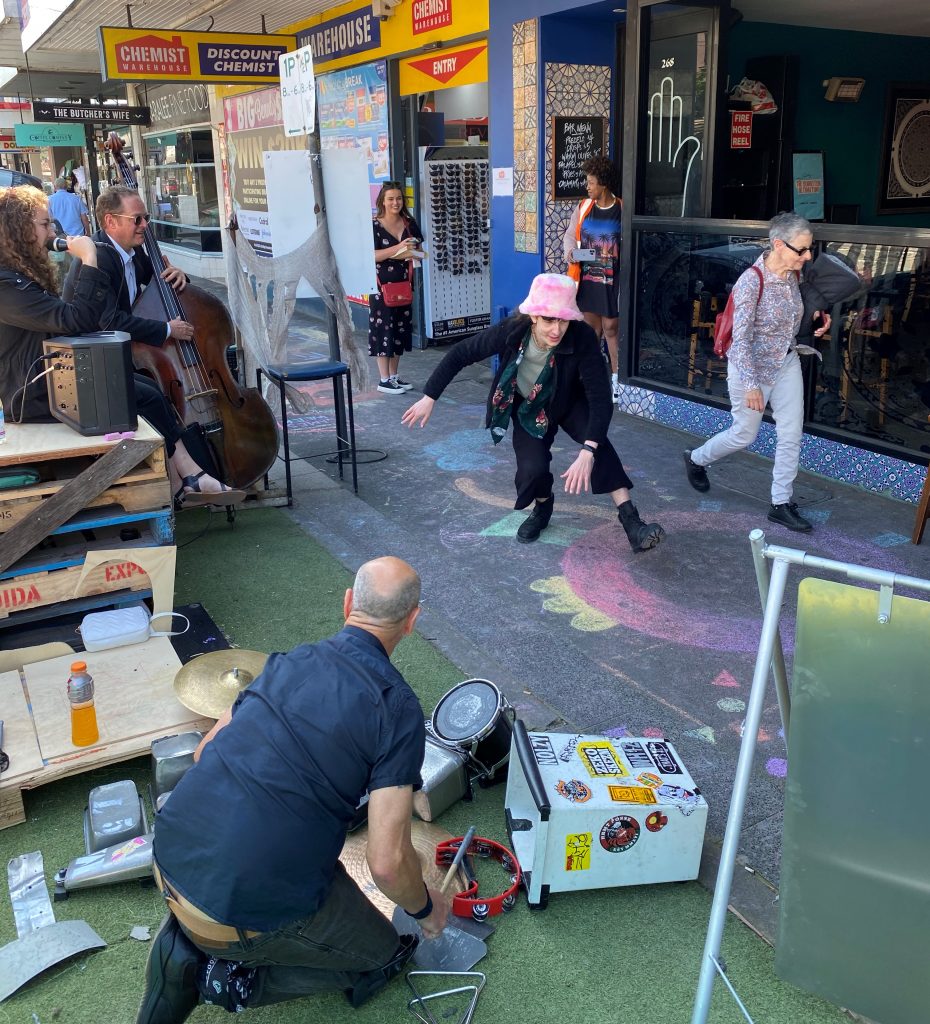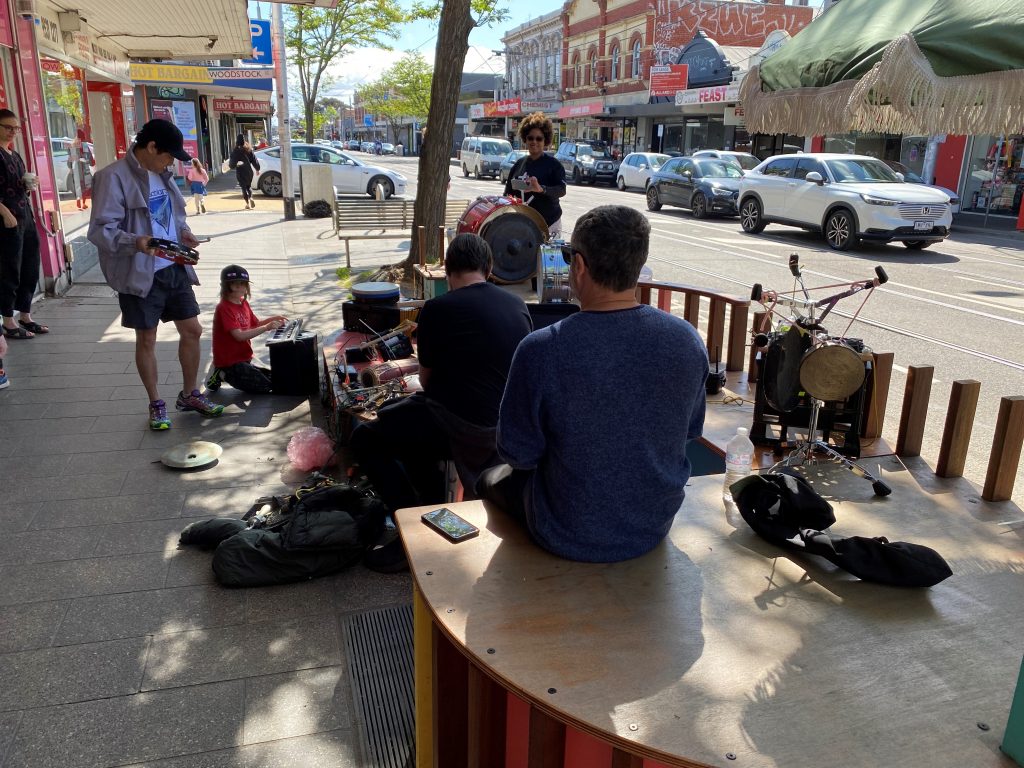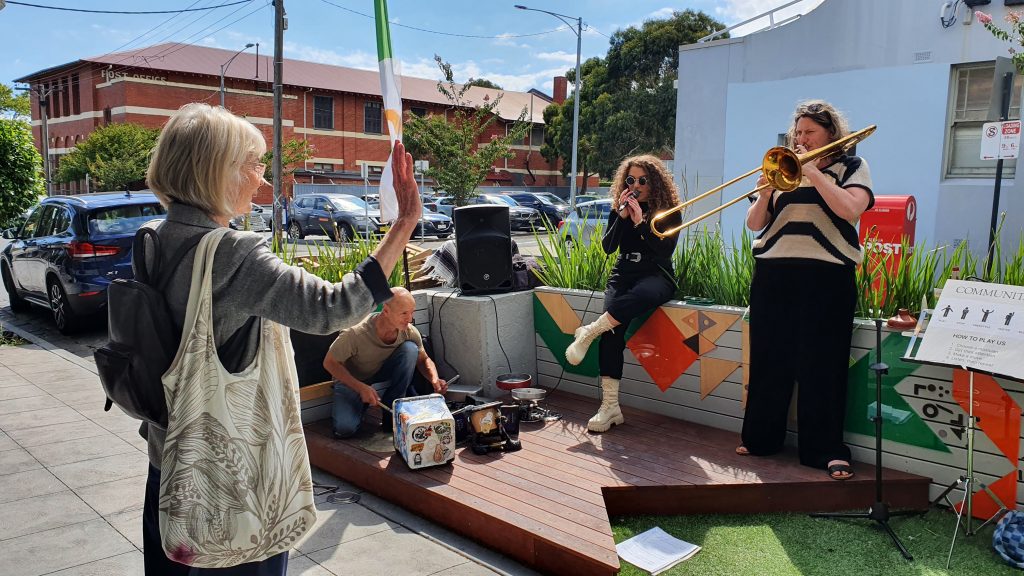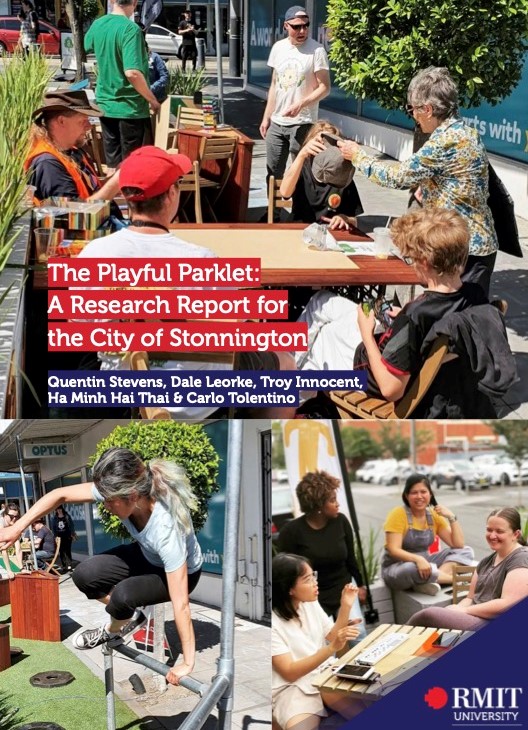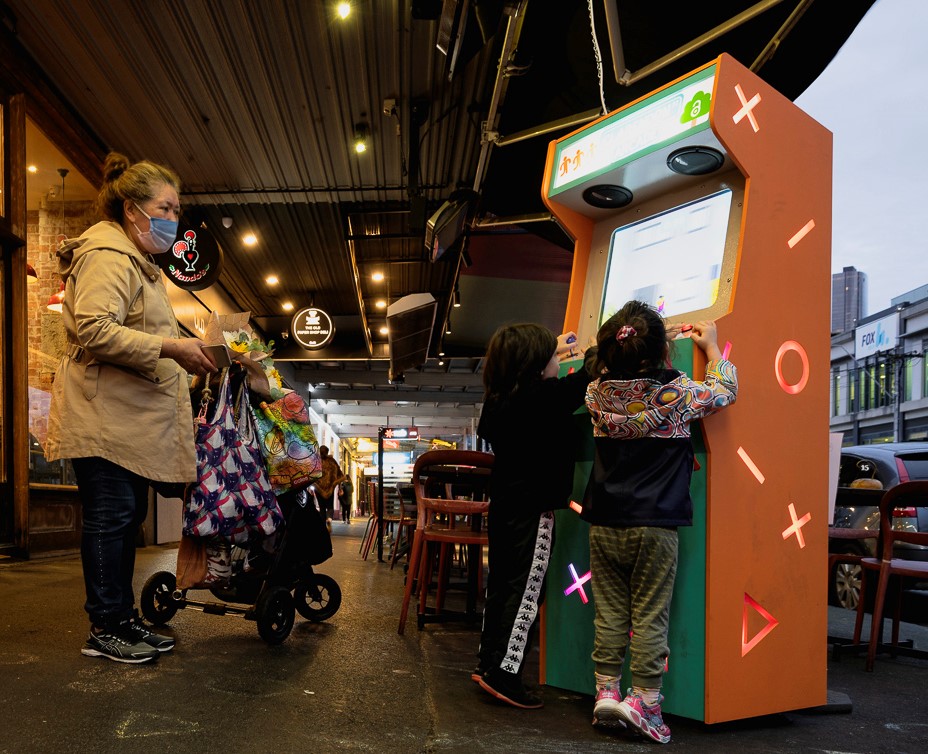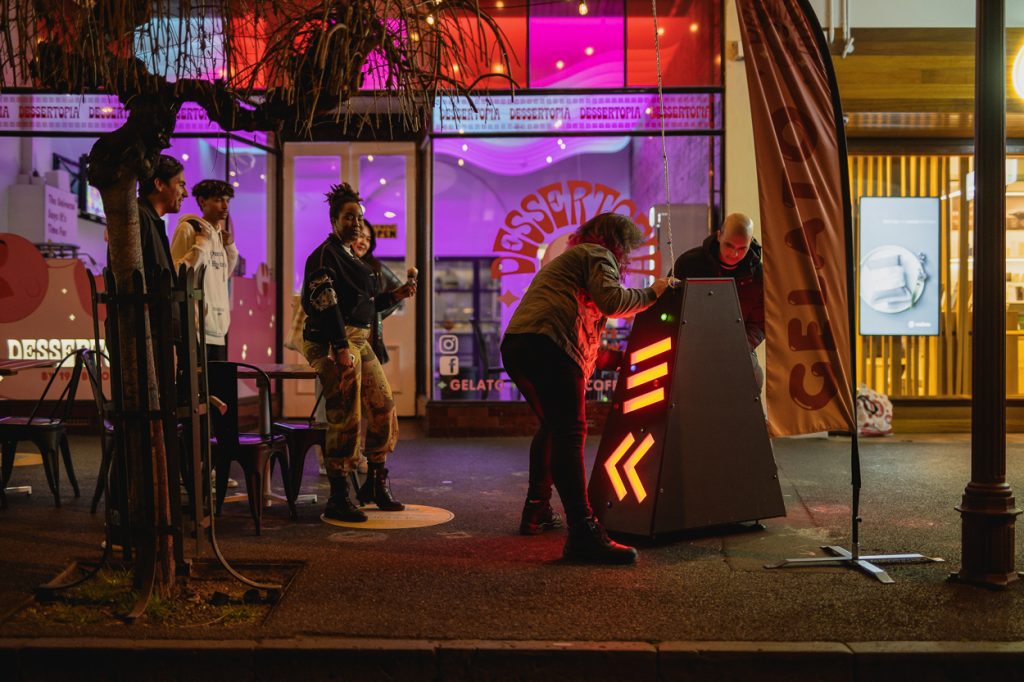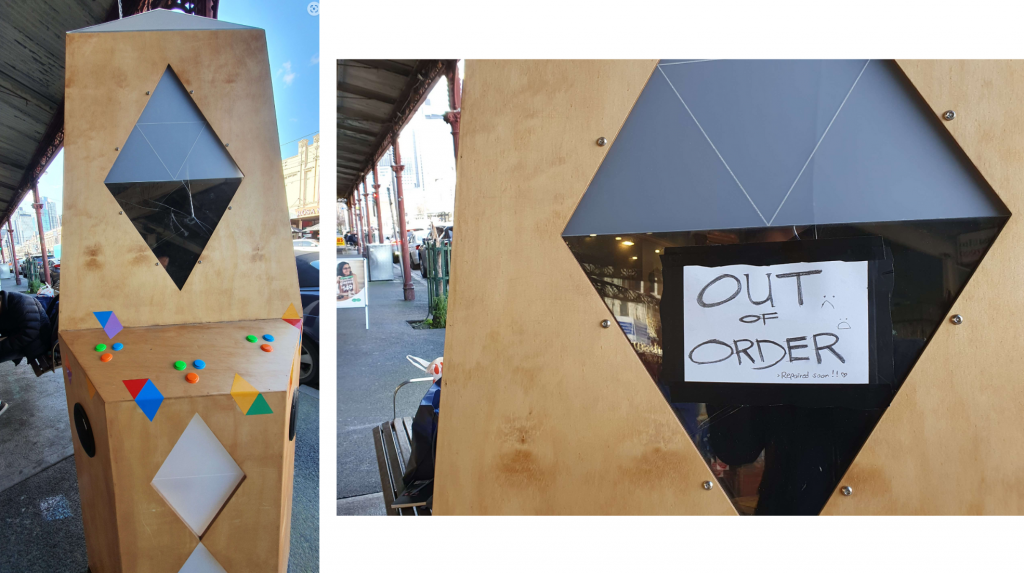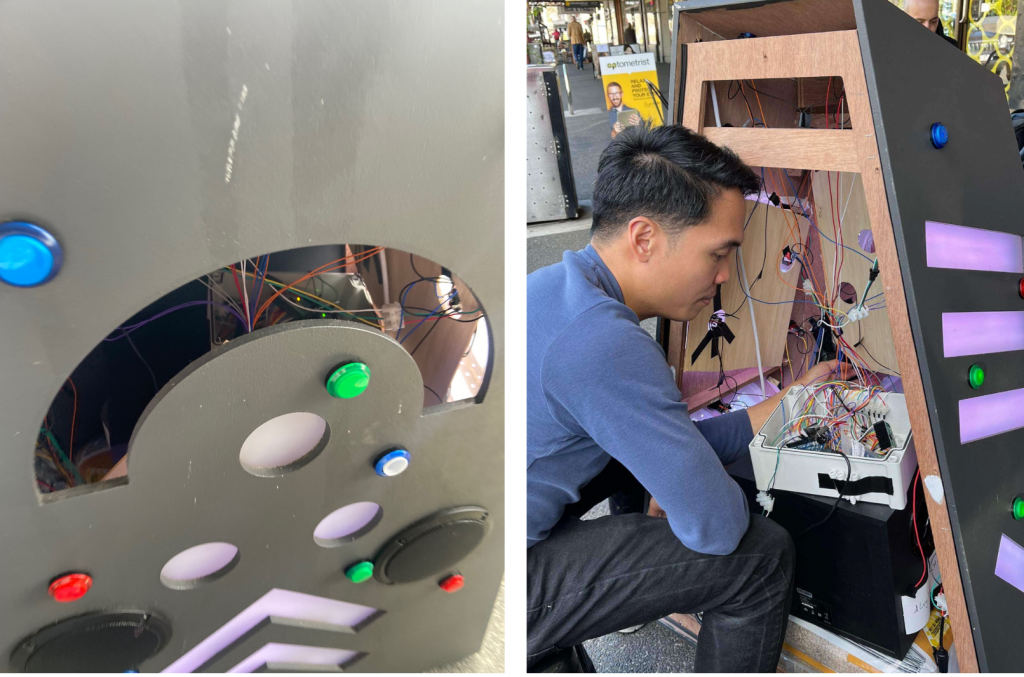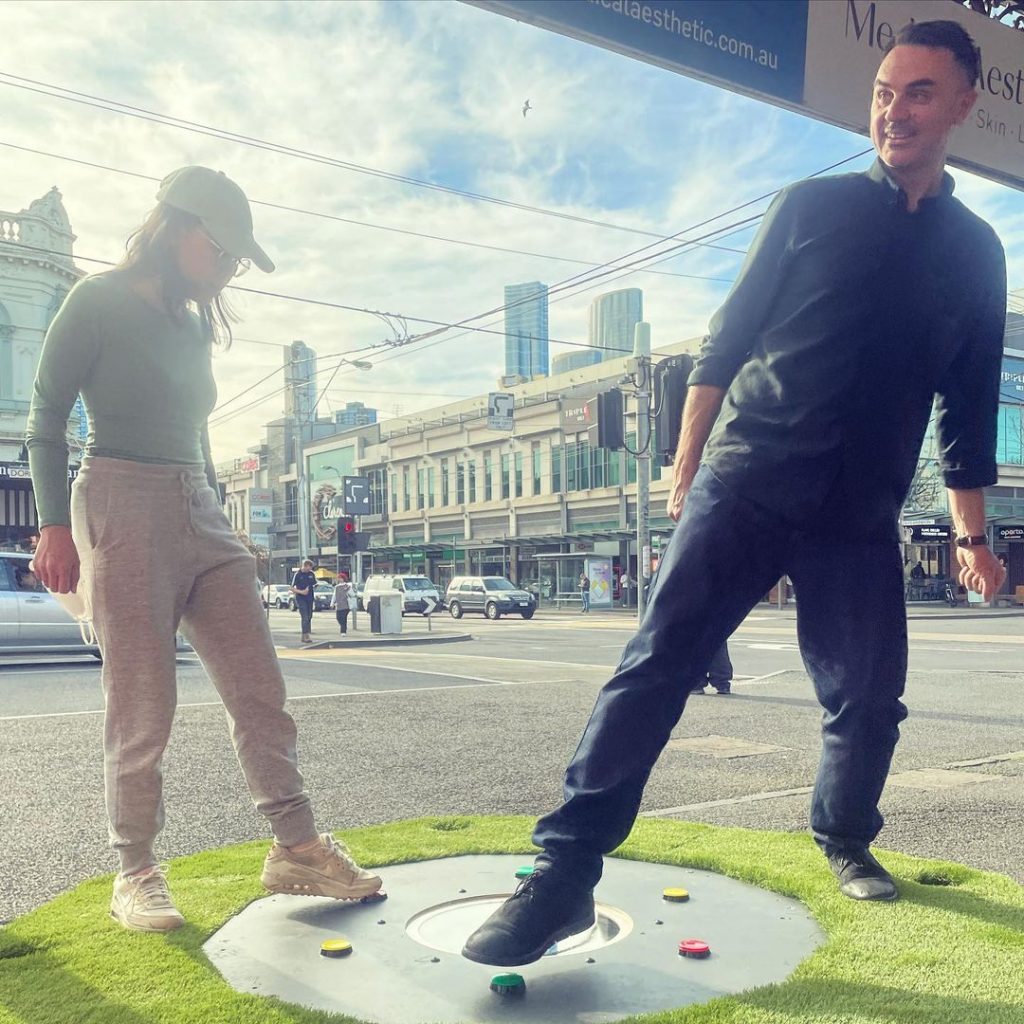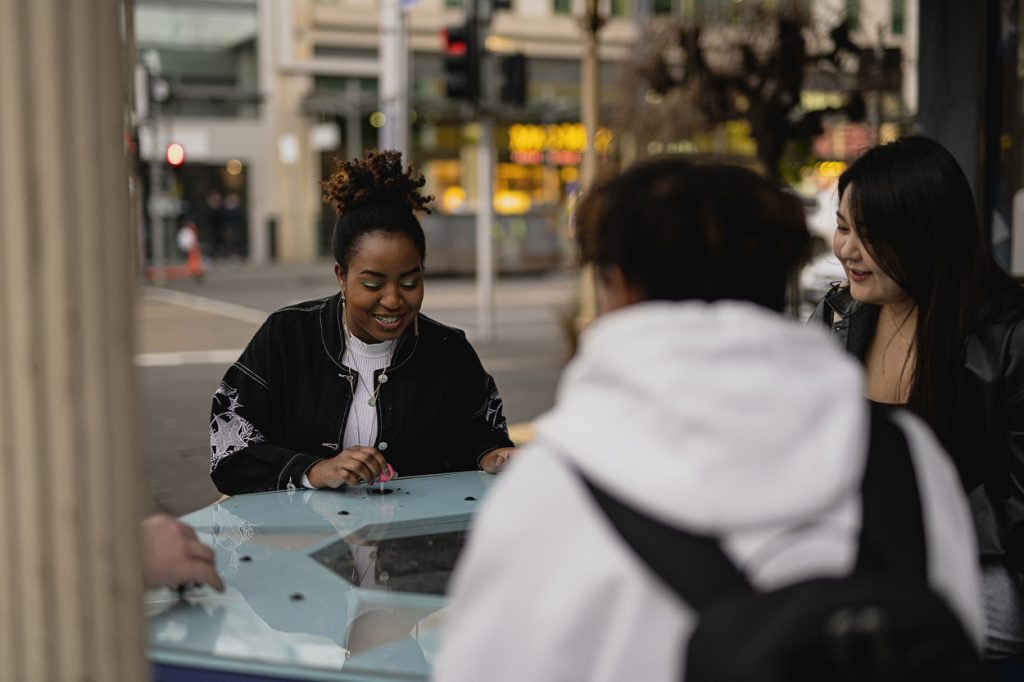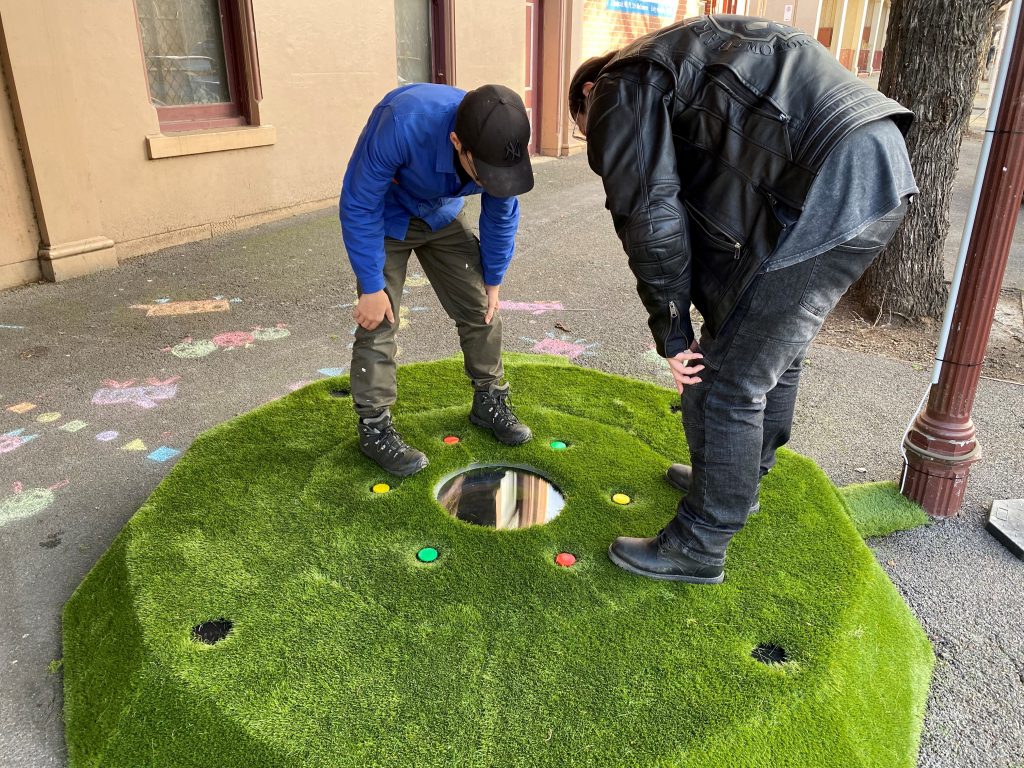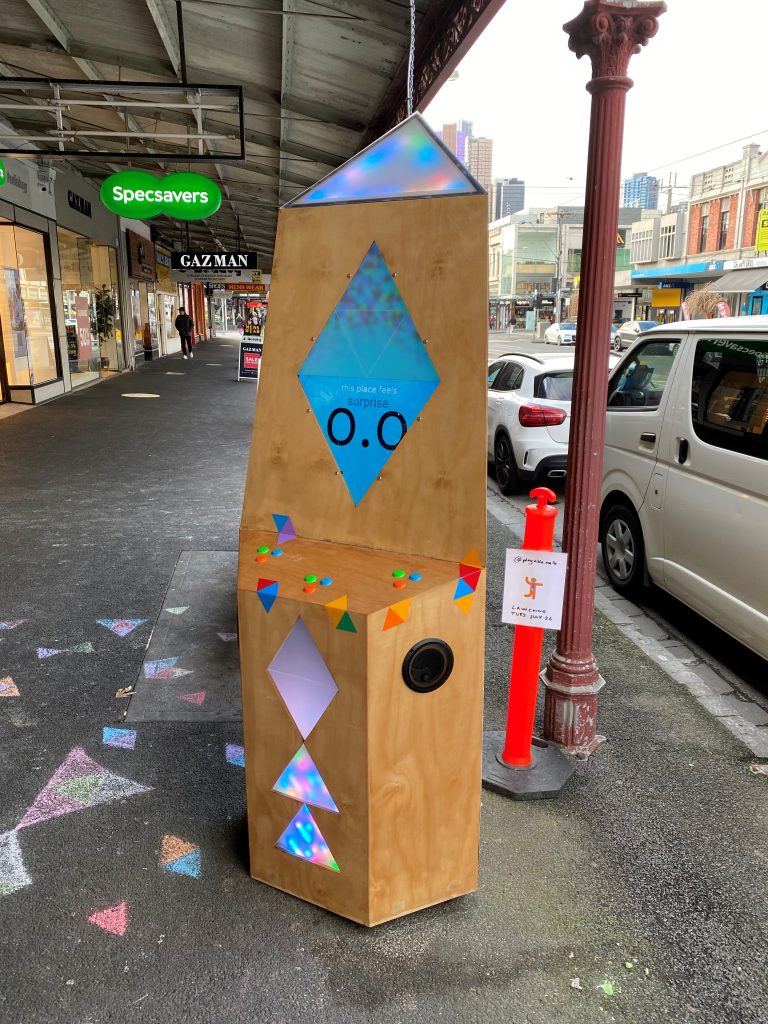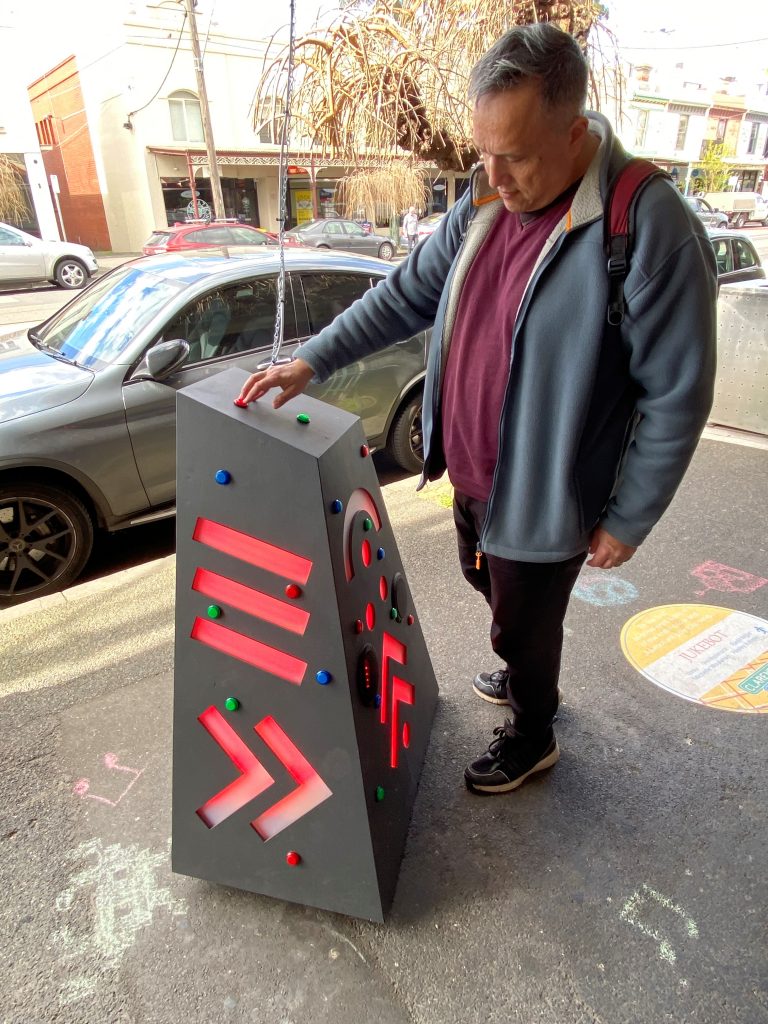Over the past month, an experiment in shared world creation through an immersive role-playing game set on the streets of Naarm/Melbourne in 2050 has played out over a series of three events at MPavilion in Melbourne. Reworlding: Play The World We Want is a speculative and relational form of world-building focused on evolution over revolution, and nurturing and developing existing patterns in culture, the environment, and society.
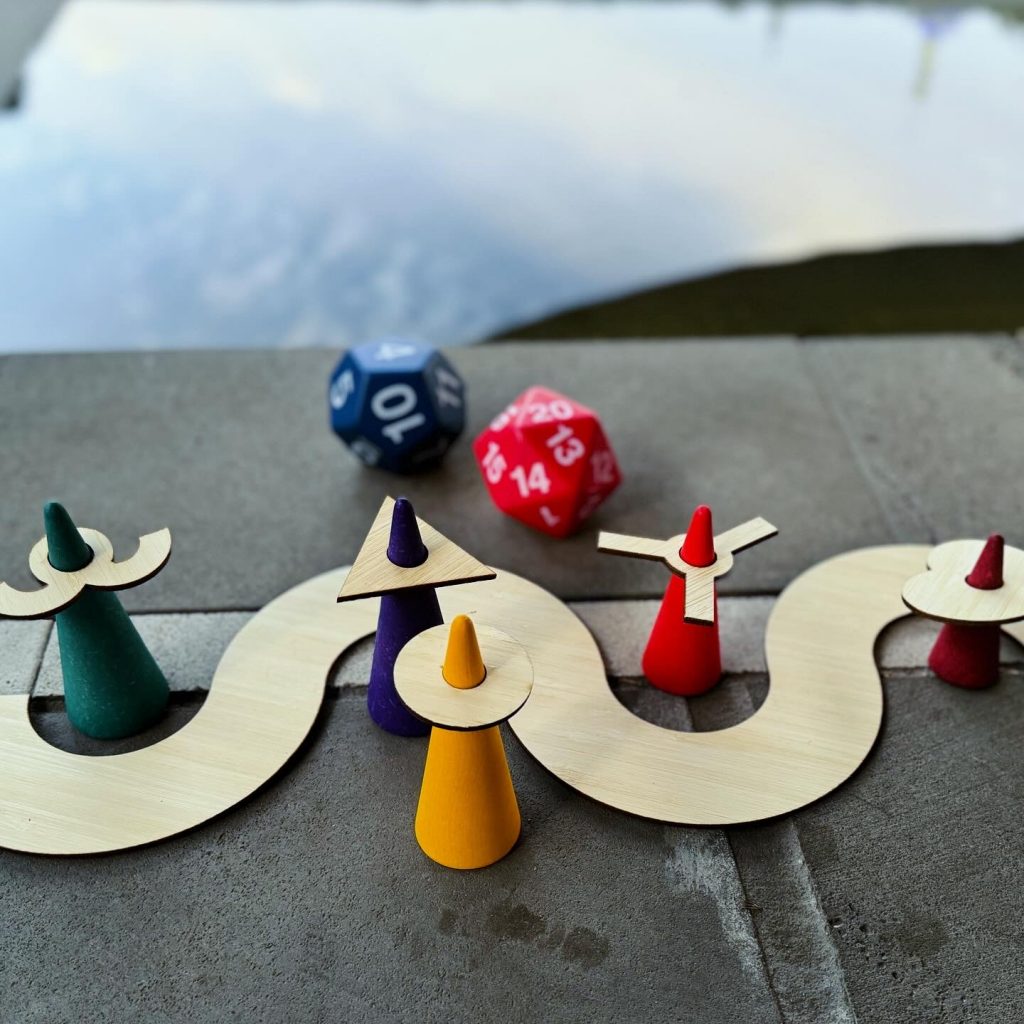
The game itself is an OSR (Old School Revival) TTRPG (TableTop Role-Playing Game) created by Troy Innocent in the RMIT future play lab. Development of the rules and setting are continuing following the three MPavilion events, but the introduction starts with the following:
Hello, welcome.
This is Narrm, also known as Melbourne, in 2050.
The City is run by AI. That’s what we’ve been told.
For you, a megacitizen living through increasing uncertainty in The City, there are three things that matter: HOPE, COMMUNITY, and SYMBIOSIS.
The game is played out through a reworlding system using roleplay, props, places and provocations. As promised to the players, here is how the final scenario played out… by the end everyone pictured below was part of Melbourne in 2050. Thanks to Aramiha Harwood for writing up this account, and to all the generous participants who played well together.
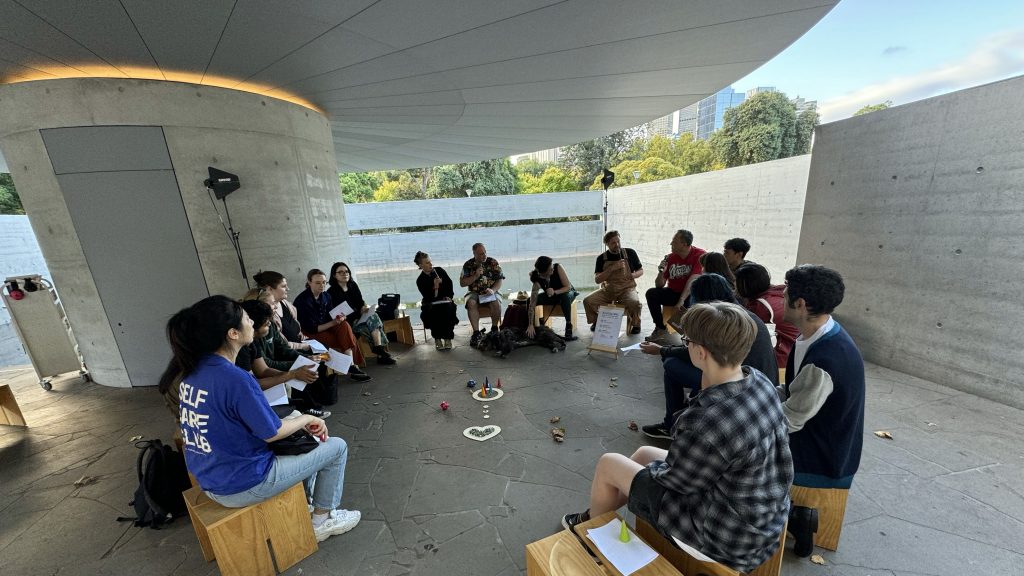
Part III.
Played on March 14, 2024
Events take place on January 3, 2050
The Cast
Virgon Accord – Metabuilder – Penelope
Maisy Ware – Metabuilder – Nic
Dusty Crispr – Posthuman Nomad – Ben
Kiian Bernard – Traceur + their trusty robot dog ‘Donkey Teeth’ – Kel
Quiznatodd ‘Quiz’ Bidness – Activist – Ara
The Reworlder – Troy
Rave music pumps in the air as the crowd heaves in time with the music. In the middle of the crowd appear Dusty and Quiz, both of them slightly disoriented by the light and noise. How long have they been dancing? Who knows?
They bump into Kiian and Donkey Teeth, who is also dancing in the crowd. They give each other a welcoming hug and they begin to socialise with others around them. They are drawn to an intense conversation between two metabuilders, Virgon and Maisy.
Virgon believes that the world needs to be perfected as data-driven built environment. If things can be controlled and masterminded, then humanity and the environment can exist in perfect harmony. What is already there, needs to be improved upon. She is strong in hope for the future and humanity, but has little time for misplaced belief in symbiosis with the natural world.
Maisy is also strong in the belief that humanity and the world can exist in harmony, but she feels that it would be better done through reciprocal and symbiotic with nature. Respectful and fluid adaptivity to the environment, rather than selfish extraction, is the only way forward.
While the trio listen to the metabuilders, they notice someone else is listening. This person introduces themselves as Vermillion – a government worker. Quiz tenses at the mention of ‘the gubment’ but fears are allayed when she says that she is a local government worker. She says she is interested in the discussion of building a better future for humanity, in fact she could help with a policy plan to make this happen. Virgon immediately regales Vermillion with her visions of this better future, and Vermillion is immediately taken with these ideas – she’ll help Virgon!
Suddenly the rave music drops a beat, and Sesame Street’s ‘People in Your Neighborhood’ starts pumping out of the speakers. Everyone knows that this means that security is on their way, so the crowd break up and start running in all directions at once.
The group – Virgon, Maisy, Dusty, Kiian, Donkey Teeth , Vermillion and Quiz – run away into the dawn, avoiding the impending security-crackdown. They are joined by a quiet fellow, Dion, who – while running – has little to say to anyone. It seems he would rather remain quiet and inconspicuous, perhaps a wise choice given the state of Melbourne and its AI.
Making good on their escape, the group pause to catch their breaths and make plans. Virgon would like to check out the Monolith which still looms above the local cityscape. She has been told about the sushi restaurant in it, and she is dying to eat some meat – perhaps beef, if they have it? No-one has the heart to tell her that the sushi restaurant only serves soylent green as a meat substitute…
Maisy wonders if there is any coffee available around them, but there is nothing about.
What to do next? The group decide that they’ll check out the Data Centre somewhere to the west – which also happens to be towards the detention centres and the raging bush fire. They slowly walk along the empty streets of Western Melbourne, the smoky haze getting worse, when they spy a lone figure walking towards them.
The figure turns out to be wearing some sort of uniform, which the group cannot identify. Approached by the group, the figure greets them all. It turns out that she is a security guard for a detention centre – she takes care of the AI security which controls the drones. The group is intrigued, wondering if they could get control of the drones. The guard says she could definitely provide five drones to the group for their use, but she also says that her current ‘mission’ is to bring criminals and hackers to the detention centre. She would need to bring someone into the detention centre as a prisoner, before she gives up control of the drones. The group deliberate amongst themselves. Maisy suggests that Kiian could go into detention, and the group could rescue her in a day or two, with Donkey Teeth’s help.
Kiian agrees to this plan and is handcuffed by the guard and taken away to the detention centre. She is processed and locked away in a cell. The guard immediately receives a promotion at the detention centre – she is now a Chief of Guards (COG). She hacks into the security AI and sends 5 drones to Virgon, who takes control of them. Talking remotely through the drones’ speakers, the new COG thanks the group for their help – if there’s anything else they need in the future, just ask her.
The group are unsure what to do next. They could wait to rescue Kiian, but it’s only a matter of time before government forces repair power to Melbourne’s AI and things return to normal – do they have very long?
Suddenly, from out of thin air, appears a person. This takes the group aback for a moment, but they cautiously greet this person. Of an Asian background, the person introduces themselves as Christi. She is a police officer.
Quiz freaks out. “RUN” he shouts, leaping to jump on Christi. She quickly clarifies that she is a RETIRED police officer, which stops Quiz in his tracks.
Christi was a police officer in China who just retired, and was looking for a place to retire. The group didn’t think to ask how Christi suddenly travelled from mainland China to Melbourne. They continue to discuss whether or not to rescue Kiian, and how they could do it. Christi suddenly tells everyone “I have this teleporter that can take me from any place to another. I call it… a magic door.” He pulls out a small device from his pocket. He will help the group, if they can help him find the perfect place to retire.
Virgon pitches the ideas of her megabuild – of a perfect planned mini-city, here on the outskirts of Megacity Melbourne – to Christi. There would be wide shaded streets and lovely shopping centres, and gleaming office-buildings for citizens to work in. The perfect place to retire!
Carlo likes this idea and agrees to teleport into the detention centre (with coordinates from Donkey Teeth), pickup Kiian, and teleport back out – with the proviso that he will have a home in this city of Virgon’s. A simple and elegant solution, and the group congratulates one another when this is done with little fuss.
Virgon would like to celebrate with a coffee, but – here on the outskirts of Mega-Melbourne – there is not a coffee to be found!
Their ideas percolating, Virgon and Vermillion are keen to build this new city, but how will it be done? As if summoned by Virgon and Vermillion a crowd of at least 100 people march down the main street on which the group stand. They are all fired up, shouting slogans and carrying XR banners.
Christi chooses this time to inform the group that he also happens to be carrying a gun – which only unsettles everyone even more.
Leading the marching group is Christian, who stops to talk to the group. She tells them that she and her community group want to claim this street. It is an important part of their community and they want to prevent the outside world from developing on it. Virgon explains her plans for a new community, and Christian thinks this sounds promising. She agrees to help Virgon, if it will help preserve this main street.
The group stop their marching and begin helping Virgon to plan out this new megabuild. People quickly mark out spaces for development, and Virgon uses the Drones to rapidly start 3-D printing the buildings. All of this activity draws out other locals. Rani approaches the group and offers to serve them chai. The group agree that, without any coffee so far, chai is just as good for caffeine. As she serves the chai, Rani lets the group know that she works with a group of activists known as the Friends of the Forest. She says that her group started the bushfires towards Geelong, but they are controlled bushfires. Controlled burns are an indigenous practice, to help regenerate the environment and renew growth.
A restaurateur also approaches the group. He is trying to establish a business in the area, and this megabuild of Virgon’s offers the perfect opportunity to do so. He offers food to the builders and the group, to help sustain them as they continue their building. Quiz asks, in vain hope, if the restaurateur has any coffee he could share, but he says that he is saving it for when he opens the business.
The roar of a truck alerts the builders of an approaching vehicle. Down the road it roars, emblazoned with the letters ‘SES’ on the sides of it. Out leaps an SES emergency worker, asking for help. Her name is Sarah, and she needs some people to come and aid her in removing some collapsed trees. She reckons that these are the last of the trees blocking government agencies from re-establishing power and connection with the AI data centre. Once these trees are removed, Mega-Melbourne will soon return to normal.
Rani says that the trees should be left to burn as they are, or else nature’s balance will be disrupted. Christian and the restaurateur feel that, if the all-powerful AI was to be restored, the street and the megabuild should absolutely be protected from the AI’s control and oversight. How could this be done, though?
Vermillion suggests contacting the COG security guard. The security guard had told the group that she was an accomplished hacker – perhaps she could hack the AI when it restarts and keep this megabuild out of the AI’s sights? When they manage to get the security guard on the radio, she assures the group that she can definitely do what they ask.
As if to back up this plan of the group’s, Sarah also lets everyone know that she knows where Claire and Mushen can be found. i.e they are underground, hacking into the AI to ensure that it remains down. If they help her restore power, she will let the group know where Claire and Mu-Shen are.
Reassured of all this, Kiian and Donkey Teeth – with Carlo and Dusty’s help – teleport to the Trees and they help to remove the trees. It is only a matter of time until the AI system is restored. What should the group do? Continue with the megabuild with this new community of people? Or find Claire and Mushen, and bring down the data centre that houses the AI?
Virgon is happy with the megabuild, and wishes for it to proceed – a happy, perfect, shiny urban system. A property developer approaches everyone and throws her support behind Virgon, suggesting she could find more people to come live there.
Quiz is not happy, he thinks that the system needs to come down for good. Rani argues that man’s relationship with nature needs to be returned to balance.
Maisy stands up and addresses the community – she argues that humans can no longer see themselves as the sole arbiter of all that happens in the environment. As people, we have a chance to build something anew in Melbourne – renew it, as it grows out of the ashes of the former AI-controlled Megacity. Much like new bush will grow from the burnt remnants of the old. Open spaces, living with the bush and the environment – respectful of it.
It is left to the community to decide. Everyone meets to discuss, and negotiate with one another. Secret Deals are struck, agreements for the future are made.
In the end, it isn’t even close. The community go with Virgon’s plans. Why? It is the will of the community, and that is enough.
The AI is restored, the system begins anew. The COG hacks into the system and protects Virgon’s mini/mega build from the AI’s sensors – it will grow on its own, independently.
Quiz shakes his head. They had the chance to bring down the all-encompassing AI system and free Melbourne’s citizens, and they’d let it slip through their fingers. He’d run out of hope, now.
He approaches Christi and asks the retired policeman to ‘magic door’ him somewhere else in this World.
“Sure” says Christi, pulling the teleporter out of his pocket “Where would you like to go?”
“I dunno” sighs Quiz “Somewhere that at least has Coffee.”


